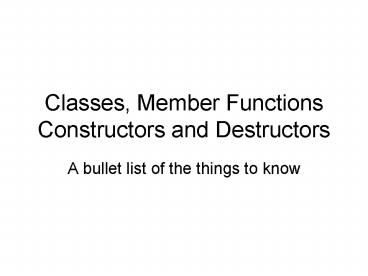Classes, Member Functions Constructors and Destructors - PowerPoint PPT Presentation
1 / 7
Title:
Classes, Member Functions Constructors and Destructors
Description:
Except members in a class are 'private' by default while members in a struct are ' ... If so, prepend T:: to the variable name and use the static data member ... – PowerPoint PPT presentation
Number of Views:22
Avg rating:3.0/5.0
Title: Classes, Member Functions Constructors and Destructors
1
Classes, Member Functions Constructors and
Destructors
- A bullet list of the things to know
2
Class
- class struct
- Except members in a class are private by
default while members in a struct are public by
default, but who cares - a class is a type
- The design philosophy of C is that you can use
any type just like you use int
3
Member Functions
- A function declared inside the class definition
is a member function - Exception static member functions are not
really member functions, more on that later - Member functions have an implicit parameter
(typically its the first parameter) - The implicit parameter is handled automatically
by the compiler (we dont declare it) - The name of the parameter is this
- The type of the parameter is T where T is the
name of the class
4
Member Functions Cont.
- We pass the implicit argument to a member
function using the x.doit() syntax - x must be a variable of type T (i.e., an object
of the appropraite class) - the value of the implicit argument is x
- The implicit parameter is used for class
scoping - When the compiler is searching for a declaration
for some variable that youre using it searches
in this order - Is there a local variable with that name? If so,
use the local variable - If not, is there a parameter with that name? If
so, use the parameter - If not, is there a data member with that name?
If so, prepend (this). to the variable name
and use the data member pointed to by this - If not, is there a static data member with that
name? If so, prepend T to the variable name
and use the static data member - If not, is there a global variable with that
name? If so, use the global variable. - What this means in practice is that you usually
wont have to use this in your programs, it
will be completely implicit. PLEASE DO NOT
FORGET HOW IT REALLY WORKS!
5
Constructors
- Constructors are functions provided to initialize
the data members of objects. - A class may have many constructors
- provided each constructors has different
parameters - If the class has one or more constructors
defined, then anyone who creates a variable of
that class will have to call the constructor - i.e., the compiler enforces/ensures that class
objects are always initialized properly. This is
a really good thing.
6
Constructors Cont
- The name of the constructor function must be the
same as the name of the class - The constructor function must be a member
function - And you can use this if you want
- We call the constructor whenever we create a
variable of that type - We put the arguments to the constructor inside
parens after the variable name - e.g., T x(1, 2) // declares variable x, 1 and 2
are arguments to the constructor for T that has
two int parameters - If it matters (and it usually does not for well
designed programs) then you can rely on the fact
that variables are constructed in the order
they are declared. - Variables defined in different files are
constructed in an arbitrary order!
7
Destructors
- Used to provide clean up for classes
- This almost always means deallocate the chunks
of memory pointed to by data members within this
class. - A class may have only one destructor
- The name of the destructor is TT
- i.e., the same as the class name but with in
front - and the destructor can have NO parameters
- The compiler will automatically call the
destructor when the activation record containing
the variable is destroyed (i.e, when the function
returns) - Global variables are destroyed when main ends
- If it matters (and it shouldnt for well-written
programs) you can rely on the fact that variables
are destructed in the opposite order that they
are constructed (i.e., LIFO)

